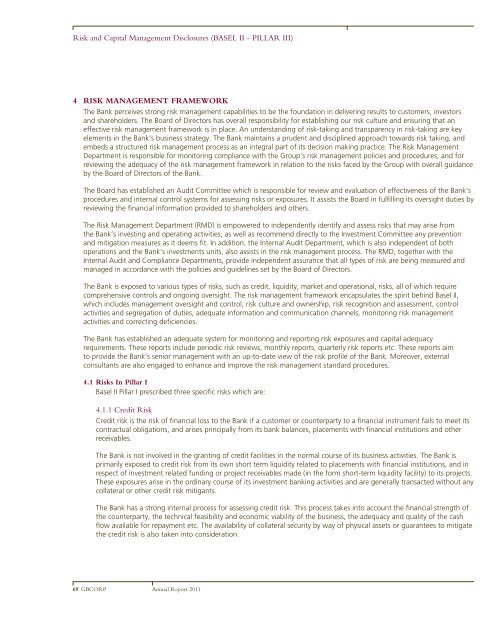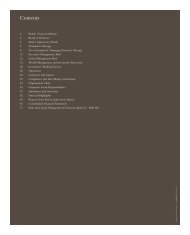GBCORP AR 2011 Basel II â Pillar III eng.pdf
GBCORP AR 2011 Basel II â Pillar III eng.pdf
GBCORP AR 2011 Basel II â Pillar III eng.pdf
You also want an ePaper? Increase the reach of your titles
YUMPU automatically turns print PDFs into web optimized ePapers that Google loves.
Risk and Capital Management Disclosures (BASEL <strong>II</strong> - PILL<strong>AR</strong> <strong>II</strong>I)4 Risk management frameworkThe Bank perceives strong risk management capabilities to be the foundation in delivering results to customers, investorsand shareholders. The Board of Directors has overall responsibility for establishing our risk culture and ensuring that aneffective risk management framework is in place. An understanding of risk-taking and transparency in risk-taking are keyelements in the Bank’s business strategy. The Bank maintains a prudent and disciplined approach towards risk taking, andembeds a structured risk management process as an integral part of its decision making practice. The Risk ManagementDepartment is responsible for monitoring compliance with the Group’s risk management policies and procedures, and forreviewing the adequacy of the risk management framework in relation to the risks faced by the Group with overall guidanceby the Board of Directors of the Bank.The Board has established an Audit Committee which is responsible for review and evaluation of effectiveness of the Bank’sprocedures and internal control systems for assessing risks or exposures. It assists the Board in fulfilling its oversight duties byreviewing the financial information provided to shareholders and others.The Risk Management Department (RMD) is empowered to independently identify and assess risks that may arise fromthe Bank’s investing and operating activities; as well as recommend directly to the Investment Committee any preventionand mitigation measures as it deems fit. In addition, the Internal Audit Department, which is also independent of bothoperations and the Bank’s investments units, also assists in the risk management process. The RMD, together with theInternal Audit and Compliance Departments, provide independent assurance that all types of risk are being measured andmanaged in accordance with the policies and guidelines set by the Board of Directors.The Bank is exposed to various types of risks, such as credit, liquidity, market and operational, risks, all of which requirecomprehensive controls and ongoing oversight. The risk management framework encapsulates the spirit behind <strong>Basel</strong> <strong>II</strong>,which includes management oversight and control, risk culture and ownership, risk recognition and assessment, controlactivities and segregation of duties, adequate information and communication channels, monitoring risk managementactivities and correcting deficiencies.The Bank has established an adequate system for monitoring and reporting risk exposures and capital adequacyrequirements. These reports include periodic risk reviews, monthly reports, quarterly risk reports etc. These reports aimto provide the Bank’s senior management with an up-to-date view of the risk profile of the Bank. Moreover, externalconsultants are also <strong>eng</strong>aged to enhance and improve the risk management standard procedures.4.1 Risks In <strong>Pillar</strong> I<strong>Basel</strong> <strong>II</strong> <strong>Pillar</strong> I prescribed three specific risks which are:4.1.1 Credit RiskCredit risk is the risk of financial loss to the Bank if a customer or counterparty to a financial instrument fails to meet itscontractual obligations, and arises principally from its bank balances, placements with financial institutions and otherreceivables.The Bank is not involved in the granting of credit facilities in the normal course of its business activities. The Bank isprimarily exposed to credit risk from its own short term liquidity related to placements with financial institutions, and inrespect of investment related funding or project receivables made (in the form short-term liquidity facility) to its projects.These exposures arise in the ordinary course of its investment banking activities and are generally transacted without anycollateral or other credit risk mitigants.The Bank has a strong internal process for assessing credit risk. This process takes into account the financial str<strong>eng</strong>th ofthe counterparty, the technical feasibility and economic viability of the business, the adequacy and quality of the cashflow available for repayment etc. The availability of collateral security by way of physical assets or guarantees to mitigatethe credit risk is also taken into consideration.69 <strong>GBCORP</strong> Annual Report <strong>2011</strong>








